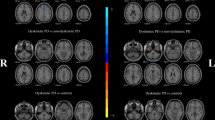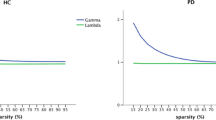Abstract
Cerebral specialization and inter-hemispheric cooperation are two of the most prominent functional architectures of the human brain. Their dysfunctions may be related to pathophysiological changes in patients with Parkinson’s disease (PD), who are characterized by unbalanced onset and progression of motor symptoms. This study aimed to characterize the two intrinsic architectures of hemispheric functions in PD using resting-state functional magnetic resonance imaging. Seventy idiopathic PD patients and 70 age-, sex-, and education-matched healthy subjects were recruited. All participants underwent magnetic resonance image scanning and clinical evaluations. The cerebral specialization (Autonomy index, AI) and inter-hemispheric cooperation (Connectivity between Functionally Homotopic voxels, CFH) were calculated and compared between groups. Compared with healthy controls, PD patients showed stronger AI in the left angular gyrus. Specifically, this difference in specialization resulted from increased functional connectivity (FC) of the ipsilateral areas (e.g., the left prefrontal area), and decreased FC in the contralateral area (e.g., the right supramarginal gyrus). Imaging-cognitive correlation analysis indicated that these connectivity were positively related to the score of Montreal Cognitive Assessment in PD patients. CFH between the bilateral sensorimotor regions was significantly decreased in PD patients compared with controls. No significant correlation between CFH and cognitive scores was found in PD patients. This study illustrated a strong leftward specialization but weak inter-hemispheric coordination in PD patients. It provided new insights to further clarify the pathological mechanism of PD.



Similar content being viewed by others

Data availability
The data and materials that support the findings of this study are available from the corresponding author upon reasonable request.
References
Aarsland, D., Creese, B., Politis, M., Chaudhuri, K. R., Ffytche, D. H., Weintraub, D., & Ballard, C. (2017). Cognitive decline in Parkinson disease. Nature Reviews Neurology, 13, 217–231.
Ashburner, J. (2007). A fast diffeomorphic image registration algorithm. NeuroImage, 38, 95–113.
Bai, T., Wei, Q., Xie, W., Wang, A., Wang, J., Ji, G. J., Wang, K., & Tian, Y. (2019). Hippocampal-subregion functional alterations associated with antidepressant effects and cognitive impairments of electroconvulsive therapy. Psychological Medicine, 49, 1357–1364.
Beaulé, V., Tremblay, S., & Théoret, H. (2012). Interhemispheric control of unilateral movement. Neural Plast, 627816.
Beeman, M. J., Bowden, E. M., & Gernsbacher, M. A. (2000). Right and left hemisphere cooperation for drawing predictive and coherence inferences during normal story comprehension. Brain and Language, 71, 310–336.
Bjekić, J., Vulić, K., Živanović, M., Vujičić, J., Ljubisavljević, M., & Filipović, S. R. (2019). The immediate and delayed effects of single tDCS session over posterior parietal cortex on face-word associative memory. Behavioural Brain Research, 366, 88–95.
Brys, M., Fox, M. D., Agarwal, S., Biagioni, M., Dacpano, G., Kumar, P., Pirraglia, E., Chen, R., Wu, A., Fernandez, H., Wagle Shukla, A., Lou, J. S., Gray, Z., Simon, D. K., Di Rocco, A., & Pascual-Leone, A. (2016). Multifocal repetitive TMS for motor and mood symptoms of Parkinson disease: A randomized trial. Neurology, 87, 1907–1915.
Chao-Gan, Y., & Yu-Feng, Z. (2010). DPARSF: A MATLAB toolbox for “Pipeline” data analysis of resting-state fMRI. Frontiers in Systems Neuroscience, 4, 13.
Chen, X., Ji, G. J., Zhu, C., Bai, X., Wang, L., He, K., Gao, Y., Tao, L., Yu, F., Tian, Y., & Wang, K. (2019). Neural correlates of auditory verbal hallucinations in schizophrenia and the therapeutic response to theta-burst transcranial magnetic stimulation. Schizophrenia Bulletin, 45, 474–483.
Chi, J. G., Dooling, E. C., & Gilles, F. H. (1977). Left-right asymmetries of the temporal speech areas of the human fetus. Archives of Neurology, 34, 346–348.
Claassen, D. O., McDonell, K. E., Donahue, M., Rawal, S., Wylie, S. A., Neimat, J. S., Kang, H., Hedera, P., Zald, D., Landman, B., Dawant, B., & Rane, S. (2016). Cortical asymmetry in Parkinson’s disease: Early susceptibility of the left hemisphere. Brain and Behavior, 6, e00573.
Cronin-Golomb, A. (2010). Parkinson’s disease as a disconnection syndrome. Neuropsychology Review, 20, 191–208.
Dashtipour, K., Tafreshi, A., Lee, J., & Crawley, B. (2018). Speech disorders in Parkinson’s disease: Pathophysiology, medical management and surgical approaches. Neurodegenerative Disease Management, 8, 337–348.
Davis, S. W., & Cabeza, R. (2015). Cross-hemispheric collaboration and segregation associated with task difficulty as revealed by structural and functional connectivity. Journal of Neuroscience, 35, 8191–8200.
Gazzaniga, M. S. (2000). Cerebral specialization and interhemispheric communication: Does the corpus callosum enable the human condition? Brain, 123(Pt 7), 1293–1326.
Gonzalez-Garcia, N., Armony, J. L., Soto, J., Trejo, D., Alegria, M. A., & Drucker-Colin, R. (2011). Effects of rTMS on Parkinson’s disease: A longitudinal fMRI study. Journal of Neurology, 258, 1268–1280.
Hornykiewicz, O. (2006). The discovery of dopamine deficiency in the parkinsonian brain. Journal of Neural Transmission. Supplementum, 9–15.
Ji, G. J., Chen, X., Bai, T., Wang, L., Wei, Q., Gao, Y., Tao, L., He, K., Li, D., Dong, Y., Hu, P., Yu, F., Zhu, C., Tian, Y., Yu, Y., & Wang, K. (2019). Classification of schizophrenia by intersubject correlation in functional connectome. Human Brain Mapping, 40, 2347–2357.
Ji, G. J., Hu, P., Liu, T. T., Li, Y., Chen, X., Zhu, C., Tian, Y., Chen, X., & Wang, K. (2018). Functional connectivity of the corticobasal ganglia-thalamocortical network in Parkinson disease: a systematic review and meta-analysis with cross-validation. Radiology, 287, 973–982.
Ji, G. J., Sun, J., Liu, P., Wei, J., Li, D., Wu, X., Zhang, L., Yu, F., Bai, T., Zhu, C., Tian, Y., & Wang, K. (2020). Predicting long-term after-effects of theta-burst stimulation on supplementary motor network through one-session response. Frontiers in Neuroscience, 14, 237.
Ji, G. J., Yu, F., Liao, W., & Wang, K. (2017). Dynamic aftereffects in supplementary motor network following inhibitory transcranial magnetic stimulation protocols. NeuroImage, 149, 285–294.
Jo, H. J., Saad, Z. S., Gotts, S. J., Martin, A., & Cox, R. W. (2012). Quantifying agreement between anatomical and functional interhemispheric correspondences in the resting brain. PLoS ONE, 7, e48847.
Kempster, P. A., Gibb, W. R., Stern, G. M., & Lees, A. J. (1989). Asymmetry of substantia nigra neuronal loss in Parkinson’s disease and its relevance to the mechanism of levodopa related motor fluctuations. Journal of Neurology, Neurosurgery and Psychiatry, 52, 72–76.
LeMay, M. (1976). Morphological cerebral asymmetries of modern man, fossil man, and nonhuman primate. Annals of the New York Academy of Sciences, 280, 349–366.
Li, J., Yuan, Y., Wang, M., Zhang, J., Zhang, L., Jiang, S., Wang, X., Ding, J., & Zhang, K. (2018). Decreased interhemispheric homotopic connectivity in Parkinson’s disease patients with freezing of gait: A resting state fMRI study. Parkinsonism & Related Disorders, 52, 30–36.
Li, P., Ensink, E., Lang, S., Marshall, L., Schilthuis, M., Lamp, J., Vega, I., & Labrie, V. (2020). Hemispheric asymmetry in the human brain and in Parkinson’s disease is linked to divergent epigenetic patterns in neurons. Genome Biology, 21, 61.
Moorman, S., & Nicol, A. U. (2015). Memory-related brain lateralisation in birds and humans. Neuroscience and Biobehavioral Reviews, 50, 86–102.
Mueller, S., Wang, D., Pan, R., Holt, D. J., & Liu, H. (2015). Abnormalities in hemispheric specialization of caudate nucleus connectivity in schizophrenia. JAMA Psychiatry, 72, 552–560.
Nichols, T. E., & Holmes, A. P. (2002). Nonparametric permutation tests for functional neuroimaging: A primer with examples. Human Brain Mapping, 15, 1–25.
Prakash, B. D., Sitoh, Y. Y., Tan, L. C., & Au, W. L. (2012). Asymmetrical diffusion tensor imaging indices of the rostral substantia nigra in Parkinson’s disease. Parkinsonism & Related Disorders, 18, 1029–1033.
Price, A. R., Bonner, M. F., Peelle, J. E., & Grossman, M. (2015). Converging evidence for the neuroanatomic basis of combinatorial semantics in the angular gyrus. Journal of Neuroscience, 35, 3276–3284.
Price, A. R., Peelle, J. E., Bonner, M. F., Grossman, M., & Hamilton, R. H. (2016). Causal evidence for a mechanism of semantic integration in the angular gyrus as revealed by high-definition transcranial direct current stimulation. Journal of Neuroscience, 36, 3829–3838.
Scherfler, C., Seppi, K., Mair, K. J., Donnemiller, E., Virgolini, I., Wenning, G. K., & Poewe, W. (2012). Left hemispheric predominance of nigrostriatal dysfunction in Parkinson’s disease. Brain, 135, 3348–3354.
Song, X. W., Dong, Z. Y., Long, X. Y., Li, S. F., Zuo, X. N., Zhu, C. Z., He, Y., Yan, C. G., & Zang, Y. F. (2011). REST: A toolkit for resting-state functional magnetic resonance imaging data processing. PLoS ONE, 6, e25031.
Stark, D. E., Margulies, D. S., Shehzad, Z. E., Reiss, P., Kelly, A. M., Uddin, L. Q., Gee, D. G., Roy, A. K., Banich, M. T., Castellanos, F. X., & Milham, M. P. (2008). Regional variation in interhemispheric coordination of intrinsic hemodynamic fluctuations. Journal of Neuroscience, 28, 13754–13764.
Thakral, P. P., Madore, K. P., & Schacter, D. L. (2017). A Role for the left angular gyrus in episodic simulation and memory. Journal of Neuroscience, 37, 8142–8149.
Toga, A. W., & Thompson, P. M. (2003). Mapping brain asymmetry. Nature Reviews Neuroscience, 4, 37–48.
Wang, D., Buckner, R. L., & Liu, H. (2014a). Functional specialization in the human brain estimated by intrinsic hemispheric interaction. Journal of Neuroscience, 34, 12341–12352.
Wang, J. X., Rogers, L. M., Gross, E. Z., Ryals, A. J., Dokucu, M. E., Brandstatt, K. L., Hermiller, M. S., & Voss, J. L. (2014b). Targeted enhancement of cortical-hippocampal brain networks and associative memory. Science, 345, 1054–1057.
Wu, J., Guo, T., Zhou, C., Gao, T., Guan, X., Xuan, M., Gu, Q., Huang, P., Song, Z., Xu, X., & Zhang, M. (2020). Disrupted interhemispheric coordination with unaffected lateralization of global eigenvector centrality characterizes hemiparkinsonism. Brain Research, 1742, 146888.
Zuo, X. N., Kelly, C., Di Martino, A., Mennes, M., Margulies, D. S., Bangaru, S., Grzadzinski, R., Evans, A. C., Zang, Y. F., Castellanos, F. X., & Milham, M. P. (2010). Growing together and growing apart: Regional and sex differences in the lifespan developmental trajectories of functional homotopy. Journal of Neuroscience, 30, 15034–15043.
Acknowledgements
The authors thank the participants for taking part in this study and thank Information Science Laboratory Center of USTC for the measurement services.
Funding
This study was funded by the National Natural Science Foundation of China, Grant/Award Numbers: 31970979, 81971689, 91432301, 81671354, 31571149, 91232717, and 81771456; the Doctoral Foundation of Anhui Medical University, Grant/Award Number XJ201532; the National Basic Research Program of China, Grant/Award Number 2015CB856405; the National Key R&D Plan of China, Grant/Award Number: 2016YFC1300604; the Collaborative Innovation Center of Neuropsychiatric Disorders and Mental Health of Anhui Province; and the Youth Top-notch Talent Support Program of Anhui Medical University.
Author information
Authors and Affiliations
Contributions
All the authors had full access to all the data in the study and take responsibility for the integrity of the data and the accuracy of the data analysis. Conceptualization, JMS, GJJ, PPH, and KW; Data Acquisition, JMS, XRG, QH, RRD, PPL and TTL; Methodology, JMS, and GJJ; Writing—Original Draft, JMS; Writing—Review & Editing, GJJ, PPH and KW; Formal Analysis, GJJ; Funding Acquisition, GJJ, PPH, and KW; Resources, PPH, and KW; Supervision, JYY and BSQ.
Corresponding authors
Ethics declarations
Conflict of interest
The authors declare that they have no competing interests.
Ethical approval
This study protocol was reviewed and approved by the Medical Ethics Committee of Anhui Medical University.
Consent to participate
The research protocol was performed according to the Helsinki Declaration of 1975 and approved by the Medical Ethics Committee of Anhui Medical University. Written informed consent was obtained from all participants after full explanation of the procedures involved.
Consent to publish
This manuscript has not been published elsewhere and the authors agree to publication in the journal.
Additional information
Publisher's Note
Springer Nature remains neutral with regard to jurisdictional claims in published maps and institutional affiliations.
Supplementary Information
Below is the link to the electronic supplementary material.
Rights and permissions
About this article
Cite this article
Sun, J., Gao, X., Hua, Q. et al. Brain functional specialization and cooperation in Parkinson’s disease. Brain Imaging and Behavior 16, 565–573 (2022). https://doi.org/10.1007/s11682-021-00526-4
Accepted:
Published:
Issue Date:
DOI: https://doi.org/10.1007/s11682-021-00526-4



